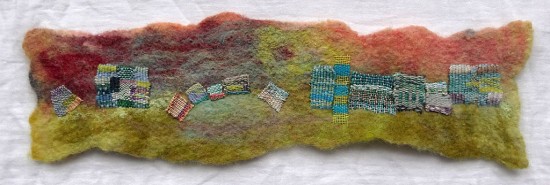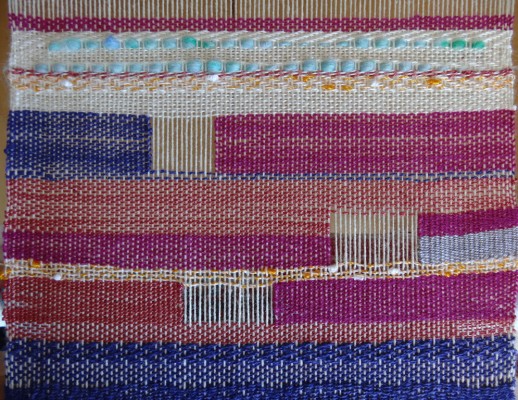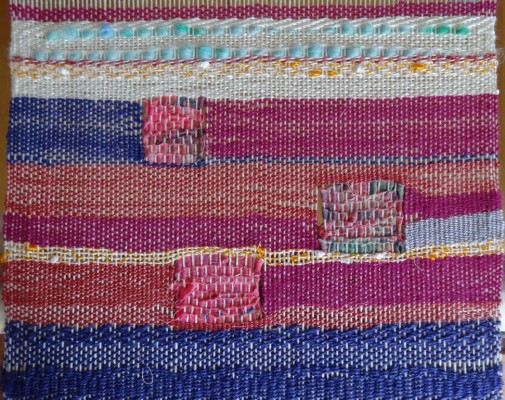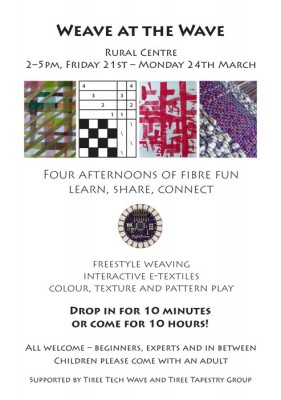I’m continuing to play with some of the ideas and thoughts that are flowing in and from Jude Hill‘s class, Considering Weave. Mixing up cloth and wool and thread. Mixing up tapestry and rag weaving and twill. Not being precious. Not worrying about ‘wasting’ time or materials. Just following the intention of the moment and watching what happens.
Considering weave
This summer I’m taking part in a class with Jude Hill – Spirit Cloth – considering weave and its relationship to stitch. I’ve never done a class with Jude before but I’ve long loved her ‘what if’ approach and it’s stimulating to be part of a curious, experimental community for a few months. We’re currently exploring weaving into cloth, a kind of intentional darning. I did a little darning last summer while I was travelling backwards and forward to Wales (where Alan was walking), inspired by the work of Hilary Hollingworth, and by the Big Mend group on Flickr.
Where I wove across a hole (as opposed to laying the warp as long stitches across the surface) I found it hard to stabilise the edges – now, watching and listening to Jude with her respectful mastery of cloth, I have learned how to do that, and gained new inspiration to try again.
Out of those experiments came this piece, ‘Island Patterns’, worked on handmade felt, without cutting. There is more of a distinction between the background and the weaving than if you fill a hole with weave. Less integration. More floating. I love weaving at this tiny scale.
Last night. thinking ‘what if’, I wove some little windows into the work I currently have on the loom.
And this morning I filled them with cloth.
I like the change of texture and scale. Looking forward to exploring this further and seeing where it goes.
Playful weaving
A few weeks ago was the 7th Tiree Tech Wave – the Tech Wave is a twice yearly design and tech retreat run by my husband Alan. This year I decided to join in the fun with ‘Weave at the Wave’, a ‘come and play’ session each afternoon in the cattle ring.
We had five looms set up, a couple of rigid heddles, a small tapestry loom, a table loom on a stand and a Saori loom with 4 shafts, plus some mini projects weaving on cards and CDs, and a box or two of LilyPad Arduino bits and pieces for e-textile experiments.
I forgot to take any pictures but there are some here by Jacqui at Tiree Living, and these are a couple of partly woven CDs. (If you want to try this I recommend this tutorial by Make It… A Wonderful Life.) People of all ages enjoyed making these.
Someone started this lovely skinny scarf on the Ashford SampleIt loom and borrowed the loom to finish it at home. It’s hard to believe she’s never woven before.
With the e-textiles, one person made dreadlocks that light up, and another wove a headband, then stitched a circuit into it that lights an LED from a battery.
I hope we’ll be able to do this again in the Autumn. In fact I wish I could think of a way to do it more often.
Since as a result I have both my ‘big’ looms set up with a cotton warp, I’ve been doing some playful weaving of my own with colours and patterns. (My looms are tiny as looms go but big when compared to our living room!)
Tiree Handmade
The Tiree Christmas Craft Fayre was at the end of November but my mind’s been on other things till now! This was our stall – some of the work is mine and some is by Jane MacDonald, another artist-maker on the island. This is the second year that we’ve shared a table. It was a fun afternoon with lots of variety. And it’s very good to have sold some work.
These were our lovely neighbours, Jacqui (The Woolly Ferret) and Amanda (Grommity)
Thoughts at the end of the course
As I’ve looked at many projects in our video-conferencing sessions, and in my own research and information sharing, there have been a few that stand out for me in terms of thinking, ‘I would love to work like that’.
- Sweet Arts in Norwich who “design and develop creative and enterprising projects that empower women to make choices that improve their health, employability prospects and general wellbeing”
- artist Sarah Wakeford who works collaboratively in education, healthcare and community settings
- Sarah Corbett and the Craftivist Collective
- Impact Arts Craft Café, a “safe, social and creative environment where [older people] can learn new skills, renew social networks and reconnect with their communities”
- The Depressed Cake Shop
And someone I’ve admired for a long time since reading her book ‘Awakening Creativity’ – Lily Yeh – “We are creating an art form that comes from the heart and reflects the pain and sorrow of people’s lives. It also expresses joy, beauty, and love.” “We … learned that in crowded, deprived, and restrictive places, we could generate new nurturing spaces of freedom, openness, and abundance through creativity and imagination.”
I think these all fall into the same segment of socially engaged art: community arts (or crafts, or cooking). They’re all focused around an element of making; one could say, like David Gauntlett, ‘social making’. They have to do with the wellbeing of individuals and communities, or making small changes that accumulate into something bigger. They are empowering. Individual and collective creativity is highly valued, sometimes simply for its own sake. There are elements of dialogue and social change, embodied in physical processes. They are inclusive. One of the projects I was most drawn to of the very many that Roxane showed us during the course was these crocheted afghans on the steps of Helsinki Cathedral, which wasn’t really even conceived as an art project (though it surely is).
William Morris said, “I do not want art for a few, any more than education for a few, or freedom for a few”. That inspires me.
There are challenging discussions going on about the whole area of grassroots ‘community-based art’ and its relationship with the more art world oriented ‘social practice’. Roxane pointed us to an article on ‘Artification‘ by Arlene Goldbard, who says that “one function of the term [social practice] is to erect a boundary between those who understand and feel comfortable in this language and those who don’t.” This article explores the same ground. It has been very interesting and helpful for me to study social practice these last few months and begin to see where I fit in.
One thing (among many!) that I take away from the course is that I want to keep studying and set aside time to read more deeply. This section of my blog was set up for the course and after today I won’t add any more to it. But I see this as just the beginning and I’ll still be blogging about it. So this post will be the last in ‘Art and Social Practice’, and also the first in ‘Community Arts’ :-).
David Gauntlett, Making is Connecting, Cambridge: Polity Press, 2011.
William Morris, ‘The Lesser Arts’, in William Morris, News from Nowhere and Other Writings, London: Penguin, 2004, p253.

























